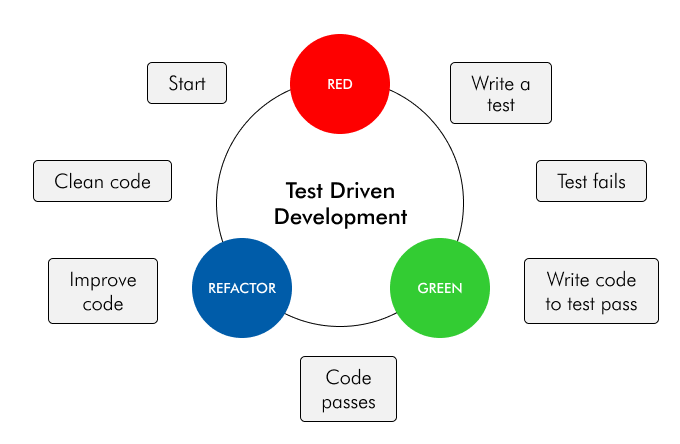


Test driven development (TDD) has become a widespread software development practice, and it is often used in conjunction with other agile development methodologies such as Scrum and Kanban.
The term “test driven development” (TDD) was coined by Kent Beck in the early 1990s. In his book “Extreme Programming Explained: Embrace Change”, he outlined the basic steps of TDD:
There is a growing body of evidence that suggests that TDD can help improve the quality of software, reduce defects, and shorten development cycles. A study by Microsoft found that TDD projects had a 60-90% drop in the density of defects. (Source)
If you are looking to witness the same drop in defect density in your software development projects, you are at the right place.
In this blog, we will delve into what test driven development is, its process, benefits top frameworks, examples, and best practices to implement TDD in your project.
Here we go!
Test-Driven Development (TDD) is a method in software development. Instead of writing code first, developers begin by creating tests. The main goal is to confirm that the code works correctly by testing it against these pre-established criteria. TDD follows a repetitive process called the “Red-Green-Refactor” cycle:
This process continues iteratively, helping developers build a robust and well-tested codebase.

Reddit users share their experience using TDD
The benefits of Test-Driven Development are numerous:
TDD encourages developers to create well-organized and structured code, which makes it easier to manage and maintain.
It helps in addressing issues early, which prevents the accumulation of technical problems in the software, keeping it more manageable.
Test-driven development provides swift feedback by detecting problems early in the development process. This accelerates development because issues are identified and fixed promptly.
With Test driven development, developers can confidently make changes or add new features without worrying about breaking existing functionality, which can speed up the development process.
Test driven development promotes a shared understanding of requirements among developers, testers, and other team members, reducing misunderstandings.
It encourages close collaboration between developers and testers, leading to more robust and well-tested software.
TDD allows developers to make changes to the code with confidence because they can rely on existing tests to quickly catch any issues, making the codebase better.
It helps teams predict how the software will behave more accurately, reducing uncertainties in project timelines.
Test cases serve as practical examples of how the code is supposed to work, making it easier for current and future developers to understand and use the software.
TDD integrates well with Continuous Integration and Continuous Deployment (CI/CD) pipelines, automating testing and allowing for frequent, reliable software releases.
Test-driven development contributes to delivering more stable and reliable software to customers, reducing the chances of critical issues in production and leading to higher user satisfaction.
Finding and fixing problems early in development is generally less expensive than addressing them later. TDD can lead to cost savings by reducing the need for extensive debugging and rework.
Incorporating Test-Driven Development into your software development process can provide various advantages, such as better code quality, faster development, and improved collaboration among team members. As a software testing company, we emphasize the benefits that make TDD a valuable practice for building dependable software.

The key 5 steps of implementing test-driven development (TDD) are:
Start by identifying a specific thing you want your program to do or a new feature you want to add.
Create a test that describes what you expect the program to do, even though the code to make it happen doesn’t exist yet.
The test should fail initially because the code hasn’t been written to meet those expectations.
Write the most basic code required to make the failing test pass. This usually means creating a function, defining variables, or writing fundamental logic.
Don’t worry too much about making the code perfect or efficient at this stage; the main goal is to get the test to work.
Once the test is successful, review and improve the code. This might mean making it cleaner, faster, or easier to understand. Make sure the code follows coding standards and best practices.
Run the tests again to check that your changes haven’t caused new problems. All tests should still pass.
Before starting new work or making changes, run all tests to check that your updates haven’t broken anything that was already working.
If any tests fail, fix the issues right away and make sure all tests pass again before moving on.
Go back to Step 1 and repeat the cycle for the next thing you want your program to do or the next feature you want to add.
Write a test first, create the code to make it work, and then improve the code as needed.
Continue this iterative approach until you’ve implemented all the desired functionality or features.
TDD encourages a systematic approach to programming, where you ensure your code works correctly from the very beginning, making it easier to maintain and less prone to errors as you build upon it.
In Agile, Test-Driven Development (TDD) is about beginning with a test that checks what your code should do. This test will fail because there’s no code yet. Then, you create the code to make that test pass. This process ensures your code works correctly and fits with Agile’s incremental and quality-centric philosophy.
In practical terms:
In a Scrum team, TDD, or Test-Driven Development, helps with adding new features or fixing bugs. First, the team writes tests to describe what the new feature should do or how the bug should be fixed. Then, they write the code to pass these tests. Finally, they clean up the code to make it easier to read and maintain.
In an Extreme Programming (XP) team, TDD is the standard approach for developing all new code. The process kicks off with the creation of failing unit tests for each new method or class.
Subsequently, the code is written to satisfy these tests, followed by code refinement to enhance readability and maintainability.
Regardless of the specific Agile methodology employed, TDD remains a valuable practice to ensure the development of high-quality software.
JUnit is a unit testing framework for Java. It is one of the most popular TDD frameworks and is used by many large companies, including Google and Amazon. JUnit is easy to use and has a large community of users and contributors.
TestNG is another popular TDD framework for Java. It is similar to JUnit, but it offers some additional features, such as support for data-driven testing and parallel execution of tests.
Pytest is a Test-driven development framework for Python. It is a very flexible framework that can be used for unit testing, integration testing, and acceptance testing. Pytest is easy to learn and use, and it has a large and active community.
Mocha is a TDD framework for JavaScript. It is easy to use and has a large community of users. Mocha is also a good choice for testing front-end applications.
RSpec is a TDD framework for Ruby. It is very expressive and makes it easy to write clear and concise tests. RSpec is also a good choice for testing APIs.
These tools provide the infrastructure and utilities needed to write and run tests effectively, making it easier for developers to implement Test-driven development in their Agile development processes.
The following are some examples of test-driven development:
If you’re building a module to send emails for an app, begin by writing tests to make sure emails can be written and sent properly. Create tests for various email formats, attachments, and cases where emails might fail to send. After setting up these tests, develop the email-sending feature to ensure it works as expected and passes all the tests.
For a flight booking apps, start by writing tests to verify that users can search for flights, book seats, and receive confirmation emails. Create test cases for fully booked flights, seat availability, and handling booking cancellations. Implement the booking system based on these test cases.
If you’re building an inventory management system for a retail business, use TDD to ensure that products can be added, updated, and removed from the inventory. Write tests for scenarios like adding out-of-stock items, updating product quantities, and generating inventory reports. Then, develop the code to manage the inventory based on these test cases.
Test-driven development (TDD) and traditional testing are two different approaches to software testing. TDD is an iterative approach where the developer writes a failing unit test before writing the code that makes the test pass. This ensures that the code is always tested and that new features do not break existing code.
Traditional testing, on the other hand, is a more traditional approach where the developer writes the code and then tests it after the fact.
Let’s check out the differences :
Test-driven development: In TDD, you begin by creating tests that outline how your code should function. These tests define the expected behavior of your code. Then, you proceed to write the actual code to meet the requirements set by these tests. In essence, you establish a comprehensive set of tests upfront before coding begins.
Traditional Development: In the traditional development approach, the usual sequence involves writing code first, without initial tests. After writing the code, tests are subsequently crafted to check and validate the code’s functionality. In some cases, tests may not be created at all or may be created as an afterthought once the development phase is complete.
Test-driven development: TDD encourages small, iterative cycles of development. You write a test, make it pass with the minimum amount of code, and then refactor if necessary. This cycle repeats until the desired functionality is achieved.
Traditional development: In the traditional approach, development often progresses linearly, with testing as a separate phase at the end. This can lead to longer development cycles and potentially more significant issues when bugs are discovered late in the process
Test-driven development: TDD aims to catch bugs early in the development process by writing tests that verify the correctness of the code. This can lead to fewer bugs in the final product.
Traditional development: Bugs may be discovered later in the development process, which can be more costly to fix.
Test-driven development: Test-driven development can encourage better software design because you’re forced to think about how to test your code from the start. This often leads to more modular and loosely coupled code.
Traditional development: In the traditional approach, the focus might be on getting the code to work initially, and design considerations can be secondary.
Test-driven development: test driven development can initially feel slower because you’re writing tests before writing code. However, it can lead to higher productivity over time by reducing debugging and maintenance efforts.
Traditional development: The traditional approach may seem faster at the outset, but it can lead to more time spent on debugging and fixing issues later.
In Test-driven development, you start by writing a failing test, which outlines the desired behavior of your code (Red).
Next, you write the minimal amount of code needed to make the test pass (Green).
Once the test passes, you can safely refactor your code to improve its design, structure, and performance (Refactor). This cycle is repeated iteratively throughout development.
Test-driven development means writing small, targeted tests that check one specific part of your code at a time. Each test should be separate from the others, making it easier to find and fix problems.
Automation is essential in test-driven development because it lets you run your tests often and reliably without having to do it by hand. Tools like JUnit, NUnit, and pytest handle the testing process automatically.
Test coverage shows how much of your code is tested. Although reaching 100% coverage isn’t always possible, it’s crucial to focus on testing the most important and complex parts of your code.
Descriptive test names are like labels for your code. A clear test name should show exactly what the test is checking, making it easier for developers to understand what it does.
CI systems like Jenkins or Travis CI automatically build and test your code whenever changes are committed to the version control system. This helps catch issues early and ensures codebase integrity in test driven development.
Read Also: What are the Key Differences Between CI/CD and DevOps?
Refactoring is the process of restructuring code to improve its quality without changing its external behavior. TDD provides a safety net for refactoring by ensuring that any regressions are quickly identified and addressed.
In Test driven development, it’s essential to test not only the “happy path” but also boundary conditions and error scenarios. Robust testing helps ensure that your code handles a variety of situations correctly.
Keeping code and tests simple reduces complexity and the likelihood of introducing bugs. Strive for elegant, straightforward solutions rather than overly complex ones.
Collaboration between dedicated developers, testers, and stakeholders is key to ensuring that tests align with the desired functionality of the software. Continuous learning and improvement of testing practices based on feedback and experience are fundamental to test-driven development success.
In the software development process, achieving high-quality products necessitates the inclusion of debugging and optimization. When integrated effectively, the Test driven development (TDD) approach offers a multitude of advantages, notably in terms of long-term cost-effectiveness and the delivery of tangible value to businesses.
In conclusion, Test driven development (TDD) is a game-changer in software development. By writing tests before code, TDD ensures higher code quality, faster development, and improved collaboration. It seamlessly integrates with Agile and offers numerous benefits, including early bug detection, better design, and long-term productivity.
TDD’s Red-Green-Refactor cycle, automated testing, code coverage, and collaboration are key practices for success. As a software development company, we at Zealous embrace TDD to build better, more reliable software, satisfying customers and saving time and resources in the long run.
Our team is always eager to know what you are looking for. Drop them a Hi!
Comments